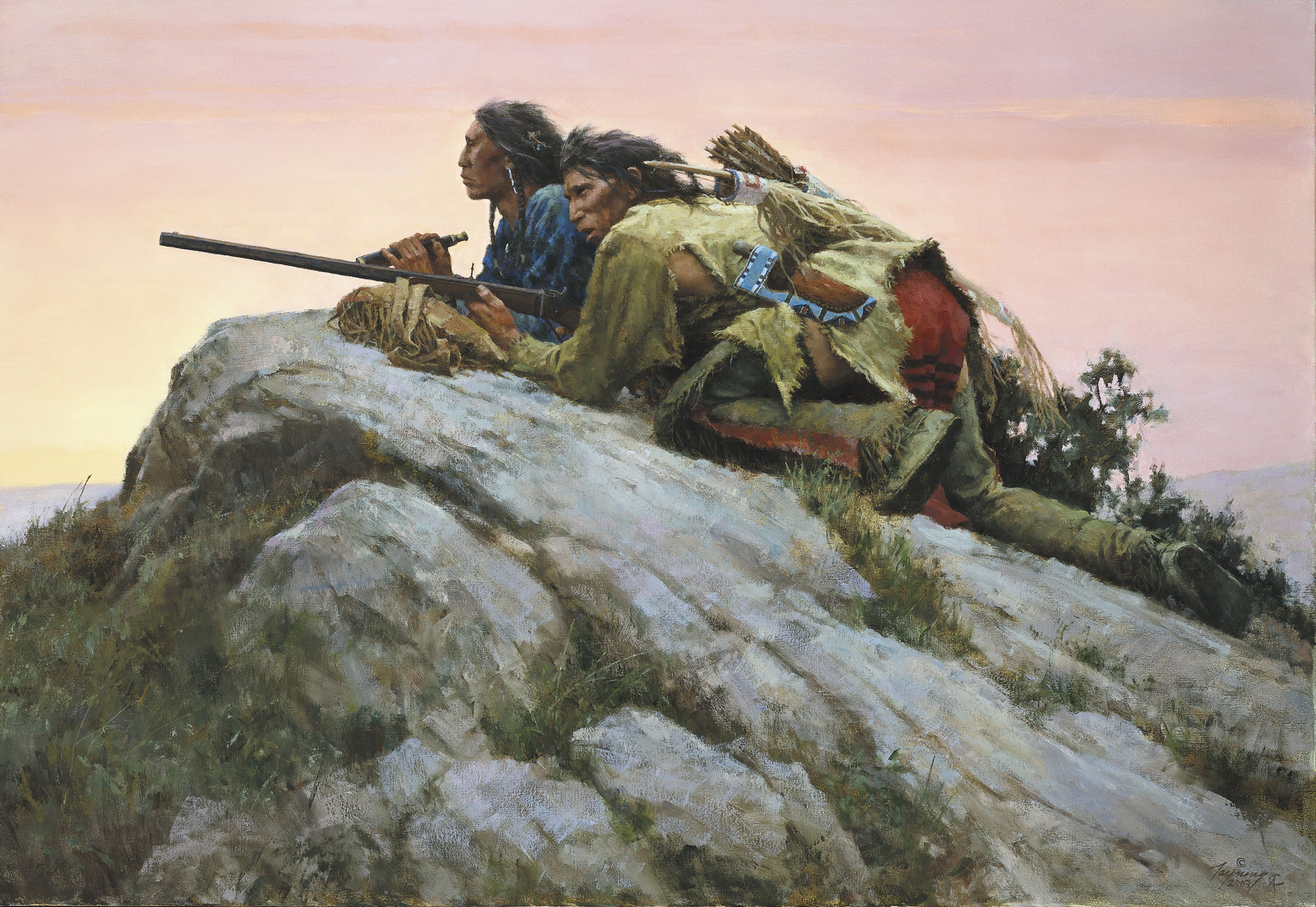
29 Dec Telling the American Story
HOWARD TERPNING, THE AMERICAN REALIST, DESCRIBES HIS OWN IDENTITY as: “First, last and always, I am a storyteller.”
At this moment, he is engulfed on four sides by wall-to-wall pictures that speak no words. Most are his own originals that one day may inhabit museums alongside the works of some of his heroes: Winslow Homer (1836-1910), Howard Pyle (1853-1911), N.C. Wyeth (1882-1945).
For now, though, and with a perplexing glance in his soft eyes as the issue of his pop celebrity is mentioned, Terpning, a graceful octogenarian, leans closer across the sofa, looks as if he’s about to make a wisecrack and shares the explanation again.
Modestly, it spills into the dry air of his Arizona hacienda and dissipates in front of paintings measuring 8 feet across and spanning centuries of time. “People ask me what kind of painter I am and how I’d like to be remembered,” he says. “It seems to be a rather odd thing to inquire about since I’m still here. The simplest answer I can give, though it may not be the one they’re after, is that I like to tell stories.”
This breathtaking understatement, insufficient to appease those who ridicule Realism, comes from a man who is clustered among the greatest living narrative painters in the United States. The fact that the fine art establishment sub-classifies Terpning as a “Western painter” who renders historical portraits of Indians has narrowed the reach of his stature within contemporary American art circles.
Nonetheless, the approaches Terpning has taken to commemorate Plains tribes on canvas has given him uncommon devotion. At its most raw, and worth witnessing for a doubting viewer, is that when aboriginal elders, whose ancestors dwelled in tipis at the time of the Civil War, pause before Terpning’s life-size epics, they often weep, men and women wrought by a vision of their heritage that reads truer to them than any oral tradition handed down.
Surviving members of the vaunted Tucson 7, a band of white-haired painters with whom Terpning is associated (it includes Harley Brown, Duane “Dick” Bryers, Don Crowley, Tom Hill, Ken Riley and the late Bob Kuhn), say the response Terpning receives from native people is a testament to their virtuosity.
“He was painting Indians, because he was intrigued by their stories, long before anyone was buying them,” says Bryers, the 98-year-old dean of the Tucson 7, as we sit in Bryers’ studio. “It was something Howard felt compelled to do. He’s never done it for the money.”
“Of all the people who have painted in the Native American genre, Howard Terpning has genuine empathy for his subject matter,” says Stuart Johnson, founder of Settler’s West Gallery that represents the Tucson 7.
Prior to my meeting with Terpning, the artist and his son, Steven, were sturdying his easel for another heroic painting, one of only five he now completes in a year that may be a capstone in his career. Massive, even by his standards, it is a monumental piece focused on a crux of the Indian saga in the western half of the continent.
What Terpning aims to convey for posterity, having contemplated the composition for decades, is the symbolic pause of anguish — the pivotal moment frozen in time — that preceded the signing of treaties. With the epochal Ft. Laramie Treaty of 1868, a flaring catalyst for the Battle of the Little Bighorn eight years later, some Plains tribes and their buffalo culture knowingly, or not, relinquished their free-roaming place in the landscape.
“I’ve often wondered: ‘What was on the minds of the Indians in the minutes and seconds before the treaty was signed? Did they have any idea of the consequences and, if they did, how wrenching it must have been,” Terpning reflects. “And what were the Army commanders thinking? Were they fully aware, in a conscious sense, of what they were doing to a race of people?”
Terpning has portrayed many historical episodes of cultural convergence, as in A Friendly Game at Rendezvous, a boisterous depiction of a trapper-Indian gathering at Pierre’s Hole along the western face of the Teton Mountains in 1832.
The original, in fact, hangs in a corner of Terpning’s home near where we sit, and collectible reproductions of the sanguine piece have been sold. However, the treaty painting, Terpning says, is somber in mood and gut wrenching, transmitted in the facial expressions of his subjects and aesthetic effects of light.
In Terpning’s Sonoran Desert abode, located in the foothills of the Catalina Mountains, he is small compared to the larger-than-life oils surrounding him. They not only fill the space and expand the feel of entire rooms but, as Terpning’s close friend, the eminent portrait artist Harley Brown says, “You can walk around inside Howard’s paintings because he invites you to inhabit them.”
Nothing has ever been written about Terpning that is not, to the informed eye, already visible or revealed in his body of work. “I could gather a group of people down at the Tucson Art Museum and, in an hour’s time, deliver a lecture about the course of art history by using just one of Howard’s paintings,” Bryers says. “All of the accumulated knowledge that he has gathered — the perceived ease of his brushwork, the sophisticated elements of composition known to European masters, the way he carefully maps every painting out, and, of course, his superb draftsmanship — it’s all there in his technique.”
Terpning’s most ambitious works have broken the million-dollar barrier at auction, but escalating market value hasn’t altered the artist’s humbling sense of mission, Bryers says, noting that Terpning’s Native American subjects are but one manifestation of his 60-year career.
Terpning’s career can be measured on a temporal curve. He is, in a 21st-century context, ancient; like the Indian traditions he celebrates on easel superstructures, he is also, in a manner of speaking, the last of his kind, equivalent to a Mohican in James Fenimore Cooper’s novel. And akin to members of a fabled tribe, Terpning spent his formative years in Connecticut, among illustrators who are no more.
As one of the few descendants of the Golden Age of Illustration — a fraternity of classically trained easel painters whose lineage dates to Mary Cassatt and Homer, Terpning and the Tucson 7, who passed through New York City before coming West, were also mavericks. They brushed up against the major “isms” being taught at art schools in the 20th century, enduring as Realists when it was never easy.
Born in Oak Park, Illinois, in 1927 (the same Chicago suburb that produced Ernest Hemingway), Terpning in his formative years was a Marine who served in China and then returned home to attend both the Art Institute of Chicago and the American Academy of Art. He went into illustration, he says, “because I definitely wanted to be an illustrator,” and his images appeared in advertising before the advent of TV.
“When Howard was a boy, his father brought him out West and he became fascinated with tribal lore of native people he saw,” Bryers says. “It continued to seep into him over the ensuing decades even when he was in the East.”
Terpning himself had been an apprentice, making $30 a week under the eminent illustrator-easel painter Haddon Sundblom (1899-1976), best known for the iconic Santa Claus advertising series for The Coca-Cola Company.
Decades later, Bob Kuhn, also a master draftsman, would remark that Terpning commanded an amazing ability to render human hands. Yes, hands, and it was no accident. Terpning tells the story of how Sundblom would, as a compliment and challenge, allow Terpning to lay in some elements of paintings he was making for his illustration projects. “To be there with him as he approached and resolved artistic problems was hugely influential,” Terpning says. “The value of the instruction I received from Sunny and the discipline you learn from illustration in having to meet fast deadlines and make decisions cannot be quantified.”
Harley Brown remembers the first moment he encountered Terpning’s work. It was 1961, beneath the marquee of the Capitol Theatre in his native Canada, and he saw the film placard advertising The Guns of Navarone with the visages of Gregory Peck, Anthony Quinn and David Niven. “Half a century later, and his work (Terpning’s) still remains vivid in my mind — imagine, a masterwork on a movie poster,” he says. “I didn’t know it was his, but it gave me an inkling of what is to come.”
Five years later, Brown, by then an art student in England, had just spent an afternoon in a gallery that was exhibiting portraits by Rembrandt. He was headed home to his flat when he saw a movie poster for the film Cast A Giant Shadow adorning the entrance to the London Underground. The image was a sketched collage of facial portraits featuring the stars Kirk Douglas, John Wayne, Frank Sinatra, Yul Brynner and Angie Dickinson.
“I was startled because you leave a gallery full of Rembrandts and you wonder, ‘Why isn’t anyone drawing like that anymore?’ Brown reflects. “But then there is this movie poster that pops up out of nowhere in front of you, and I remember thinking, ‘Great drawing still exists. It has just assumed a different modern form.’ ”
And it was by the same artist.
Indeed, it was Terpning’s posters for those films and such blockbusters as Cleopatra, Doctor Zhivago and The Sound of Music that greeted moviegoers. Smiling, Terpning shrugs off any notion of self-satisfaction that tens of millions of people around the world were seeing his work back in those days, an exponentially larger number than those who have encountered his paintings.
“Was it fun? Yes. But to be honest, it wasn’t something you think about or rest your laurels on, because it was just what I did, and as soon as one project was completed, I moved on to the next,” he says. “It was the same thing for every illustrator and you didn’t have time to sit down and pat yourself on the back. What I can tell you is that I was fortunate to have art directors making the assignments for my movie work who gave me latitude and did not micromanage my ideas.”
By the 1970s, TV and modern photography had killed traditional illustration. Terpning and his wife, Marlies, and their infant son, Steven, were ready for a change, having become smitten with the West during vacations they took. Again, Terpning notes, “Unfortunately, my previous work as an illustrator did nothing to ensure that I could succeed as a painter. You grow your credibility piece by piece.”
They settled in Tucson in 1976. Serious collectors immediately recognized Terpning’s deeper talent, Johnson says. While other artists today constantly seek members of the Tucson 7 for critiques, they might paint outdoors together but their social cohesion was never about a desire to talk shop with one another. Brown says each man had earned a national reputation before arriving in Arizona, possessed inner confidence and went his own way with an artistic style that did not overlap with his peers.
Casey Kuhn says the bond of brotherhood solidified the relationship between Terpning and his father, the late Bob Kuhn, widely considered the best big-game painter in the world. “The fact that they came up through the ranks and recognized that greatness of talent couldn’t be faked enhanced their mutual respect,” he says. “Everything they did evolved from knowing the craft from the bottom up.”
In many respects, Casey Kuhn adds, the Tucson 7 were like Renaissance men. “They are not only good artists but people of broad interests who are well read, or gifted with music (Brown is also a professional pianist), or interested in woodworking, or seekers of adventure through hunting and fishing. They weren’t nerds who sat in a studio and had nothing else to fill up their lives.”
In 1981, Terpning won the Prix de West Invitational Purchase Award at the National Cowboy & Western Heritage Museum’s annual exhibition for his piece Moving Day on the Flathead, of a tribe moving on horseback through river bottom jumbled with boulders. He repeated the Prix de West feat in 1996 for his piece The Trophy, portraying a warrior hoisting an Army bugle in the air.
“His works are, in a way, interactive,” Brown adds. “What attracts me to his paintings are the same things that have attracted me to his work since 1961. Howard’s vision possesses that magical quality that makes you stop and take notice, the same way I took notice when I first heard Chopin’s Polonaise, viewed an original Degas and encountered Greta Garbo in Grand Hotel. Beauty is something you can’t explain.”
His painting appears effortless, Bryers notes, but “It takes a long time to arrive at a simple solution. One stroke leads to another, and the direction you take is what follows. Sometimes, it takes you in a new direction. The challenge is being able to recognize whether or not it’s a place where you want your creativity to go.” What goes unseen in a Terpning is meticulous pre-planning with design.
Consider Terpning’s Lady of the House, that portrays an encampment of tipis, fronted by a stoic mother, proudly showing off her striped dwelling and banded color — doubtless the only one of its kind in the neighborhood. The scene, upon reflection, indulges a question: How is this woman any different from her modern descendants partaking, say, in a local realtor’s annual parade of homes?
Terpning is not attempting to be clever, as Grant Wood was with American Gothic, his signature ode to agrarians. Lady of the House is Terpning’s presentation of a matron (and daughter beside her) who is more a commentary about the common humanity of his subjects than as some exotic, seemingly foreign counterpoint to what real America is.
He speaks of miracles that occur with brushstrokes, in plein air field studies or complicated easel paintings, that push emotional buttons or hold elements of genius. “If I knew how and when they happen, I would reproduce it on canvas in every piece,” he said. “Occasionally, everything comes together in a moment. You thank God for it and wonder if it will ever happen again.”
Terpning’s paintings promote an emerging vision of history rather than a receding one forever trapped in a past that can no longer be accessed.
In Captured from General Crook’s Command, he dramatically portrays a group of Apache raiders who have outfoxed the U.S. Army and secured supplies for their starving people from the control of Indian fighter General George Crook. It is Howard Pyle-esque in that subject matter is transcended by technical painterly execution.
With Three Generations, Terpning delivers a soothing tonal portrait of native grandmother, mother and daughter. And in Gathering for the Sundance, he documents a little-known ceremony in which women gather a certain species of sagebrush prior to the Sundance. Both of these pieces echo of the seminal Ten, the group of American Impressionist portrait painters at the turn of the last century who included Frank Benson, Edmund Tarbell and William Merritt Chase.
Terpning is not a false romantic, a portrayer of Indian woes to engender sympathy, nor is he an apologist. He merely aims, he says, to provide views — if not from what some might consider a native perspective (though he is not native himself), then at least through the lens an objective visitor might have found by going back in time. In order to make an imagined scene believable, it must be authentic.
He is known for his voracious accumulation of research materials, be it sketches made on location, amassing a photo library, gathering grainy historic black-and-whites or studying artifacts. “When I look at historic black and white photographs of Indians, I always see them in color,” Terpning says.
At Settler’s West, Johnson points to the pattern of beading on a ceremonial Indian object, associated with a specific tribe. He says Terpning knows the tribal nuances and insinuates them subtly into his work.
Boilerplate to Terpning’s sensibilities are an unflinching inclination to make personal statements through gesture, optical flow of focal points, careful attention to value, and design, rather than giving in to the tendency some painters have of seizing attention with bright pigments squeezed from the tube. Although his paintings actually read as bold declarations, Terpning’s choice of palette is typically restrained in order to ensure that narrative is the first impression imparted upon a viewer.
It’s not only Terpning’s viewers who are sometimes moved to tears. Years ago, he and Marlies were left riveted by a written account of a little-known engagement between the U.S. Army and Northern Cheyenne Indians on the Kansas prairie. Refusing to settle on a reservation, a band of Cheyennes headed north and ran into troopers on horseback along the banks of tiny Sappa Creek.
Terpning learned the actual battlefield lay on a farm and even the existing residents were unfamiliar with what had happened there a century earlier. He needed to see the landscape before he could ever conceive of a painting, so he boarded a series of commercial flights and finally took a puddle jumper into the area. A local deputy sheriff escorted him to the site.
Rather than a clash of fighters, the confrontation actually included a slaughter of Cheyenne women and children. When faced with an imminent attack, the story goes, the Cheyennes hunkered down and frantically attempted to gouge a protective bunker into rocky soil with sticks, axes and bare hands. It is said that after the killing had stopped, the spirit of a slain Cheyenne leader escaped into the sky as a raptor.
“We walked out there and the wind was blowing hard and the magnitude of what the Cheyennes were up against became clear by the lay of the land. You had mothers watching their husbands die and trying to create some kind of barrier between the soldier’s bullets and their children.” Terpning now pauses. He is silent. Tears fill his eyes, then roll down his cheek.
A minute passes, and he continues telling the story. “I knew then what I needed to paint. As we were leaving, the breeze stopped and a red-tailed hawk came circling above us. You can read into it whatever you want.”
Terpning’s painting, Digging In at Sappa Creek, captures the frantic commotion before the cavalry blew in like a storm, and yet it is a fury of hueful beauty and a haunting contrast between light and shadow, abstract shapes and stark pain in the faces of his subjects.
If art is good medicine, then the presence of Digging In at Sappa Creek and reproductions of other Terpning paintings show how his work has been adopted by leaders in Indian Country. In Denver, more than 100 of his prints, gifted by collector Clancy Herbst of Aspen, decorate the Nighthorse Campbell Native Health Building at the University of Colorado’s Anschutz Medical Campus.
“Howard has a very quiet, unassuming nature,” Johnson says. Similarly, he adds, there’s an understated sense of refinement, and a lack of ostentation with the way he paints, whether it’s a portrait or multiple human figures. “The attitude toward painting he has is part of a continuum that’s soon coming to a halt. If he lived somewhere else, in a European country, he’d be ensconced in a castle and treated as a national treasure.”
Twenty years ago, Roe and Beverly Hatlen wandered into a gallery in Scottsdale and were left mesmerized by a Terpning painting, Stopping Along the Flathead, depicting a native woman and man leading their horses to drink at the famous Montana river. “The art floored me so much we bought the piece,” and Roe Hatlen says. “It’s a wonderful portrayal of a moment in time.”
Hatlen credits Terpning’s wife, Marlies, with being a silent partner in his painting career. “He and Marlies are a team. From my perspective, no one has portrayed Plains Indians as masterfully as him. He captures their soul, spirit and does it respectfully in everchanging ways. He is continually delivering surprises.”
As demand for Terpning’s originals backed up over the years, the artist grew tired of the growing pressure, and so to put his images into wider circulation agreed to reproduce several pieces, with the original buyer’s agreement, in limited-edition prints, including giclees. However, any original that is marked with a heart next to Terpning’s signature means it is a piece that his wife has chosen to keep after so many have gotten away.
Is Terpning the “next” Frederic Remington or Charlie Russell, as some organizers of the Coeur d’Alene Art Auction have intimated? Is it justified to diminish Terpning, as The New York Times did, for instance, in mentioning his connection to the legacy of illustration that served as a potent training ground for American fine artists? Is Realism less valid than, say, non-objective motifs and Abstract Expressionism, considering that da Vinci’s The Last Supper was a narrative painting, and so was Emanuel Leutze’s piece Washington Crossing the Delaware?
Terpning himself says those are valid ponderances, but he believes the conclusions are open ended and history will render a verdict, just as it did for his predecessors.
Who would have guessed that Edgar Paxson’s 6-by-9-foot painting, Custer’s Last Stand, finished in 1899 but begun eight years earlier, and today a treasure at the Buffalo Bill Historical Center in Cody, Wyoming, would become such an enduring icon?
On a hot October afternoon, with the temperature reaching 95 degrees, Terpning could not wait to get back into the cool of his studio and leap into his treaty painting, ready to be born after a long incubation. “I’ve been thinking about it for 15 years and now that it’s in my conscious state of mind I feel as if I can let it go free,” he says.
Johnson believes time will shine kindly upon Terpning’s grand narratives, just as it has for Homer, Pyle, Wyeth and Paxson. “Our work is an expression of ego, whether we like to admit it or not,” Bryers says. “But we are not in a competition with each other. It is a battle within ourselves to go a little farther.”
Those critics who seek to demean the tradition of representational painting to which Terpning subscribes forget that before he died, Vincent van Gogh mentioned Pyle specifically as an artist in a letter to van Gogh’s brother. Did it matter whether it was the subject matter or the method that lingered in van Gogh’s memory? In his own handwriting, the Post-Impressionist said the narrative work had “struck me dumb with admiration.”
Todd Wilkinson lives in Bozeman and has written about art for 20 years. Currently he is writing an environmental biography about Ted Turner.
- “A Friendly Game at Rendezvous” | oil on canvas | 54 x 60.5 inches
- “Captured from General Cook’s Command” | oil on oanvas | 34 x 56 inches
- “Lady of the House”, oil on canvas, 30 x 40 inches
- “Gathering Sage for the Sundance” | oil on canvas | 40 x 36 inches
- “Camp at the Cougar’s Den” | oil on canvas | 40 x 50 inches
- Howard Terpning






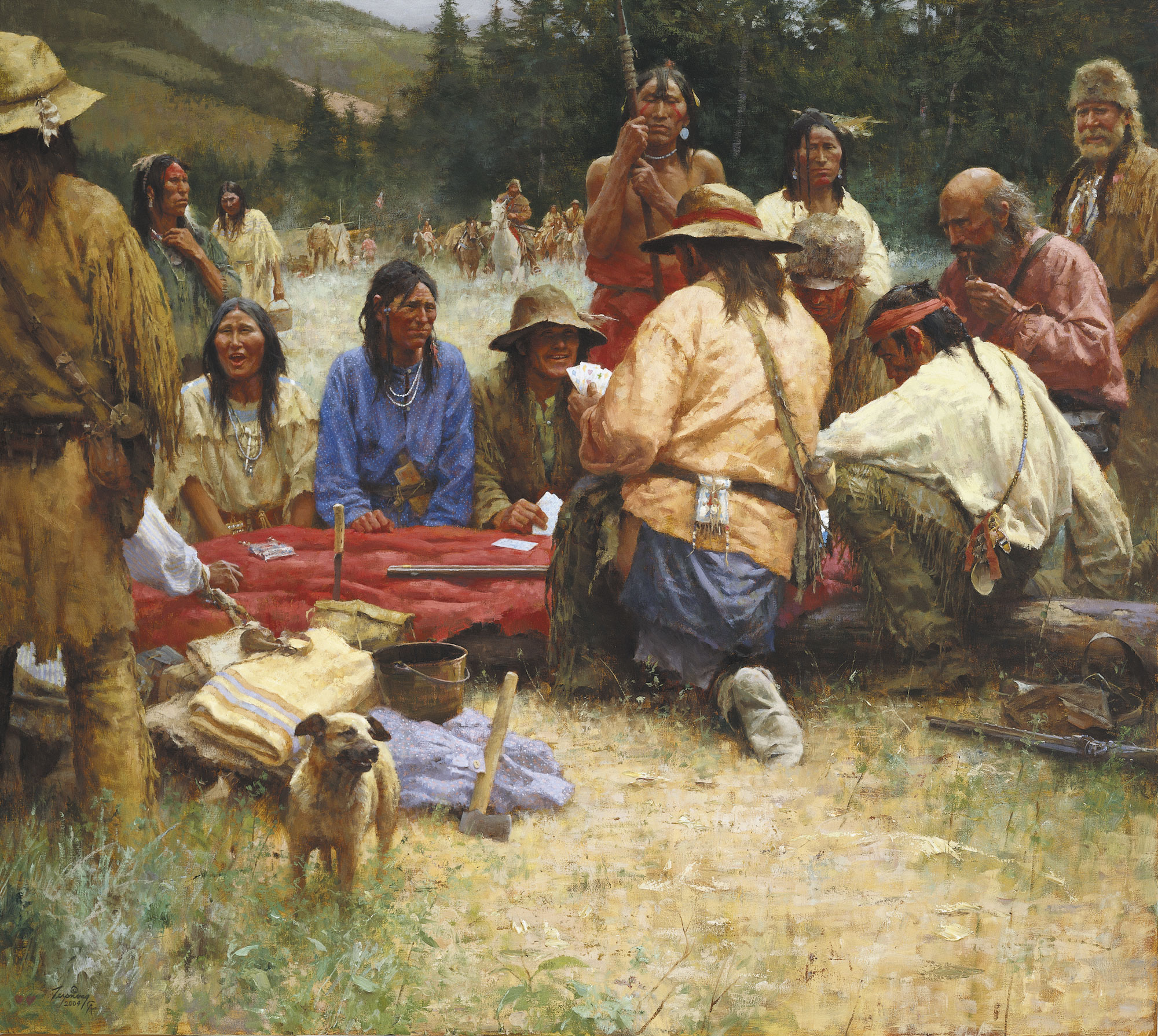
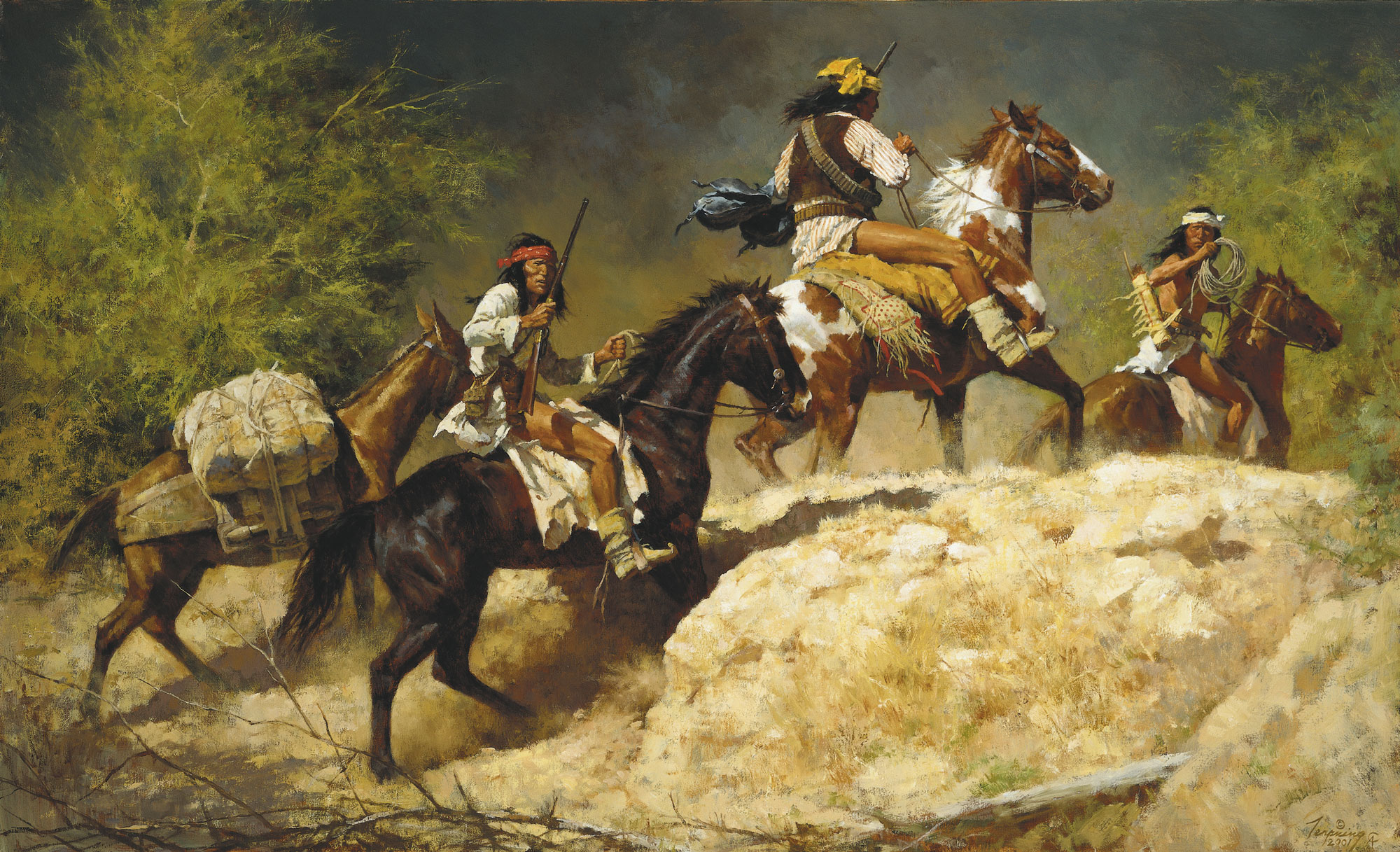
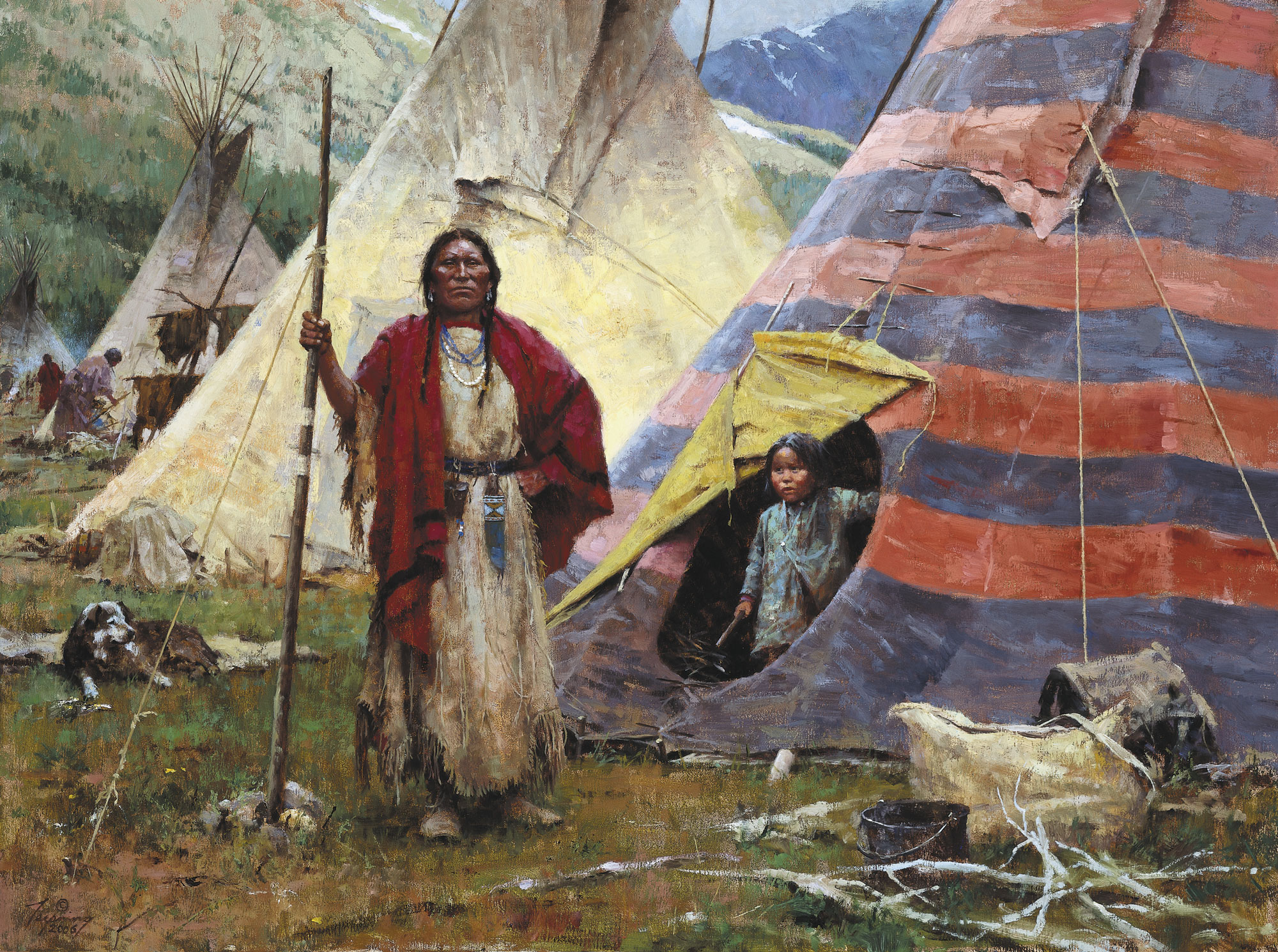
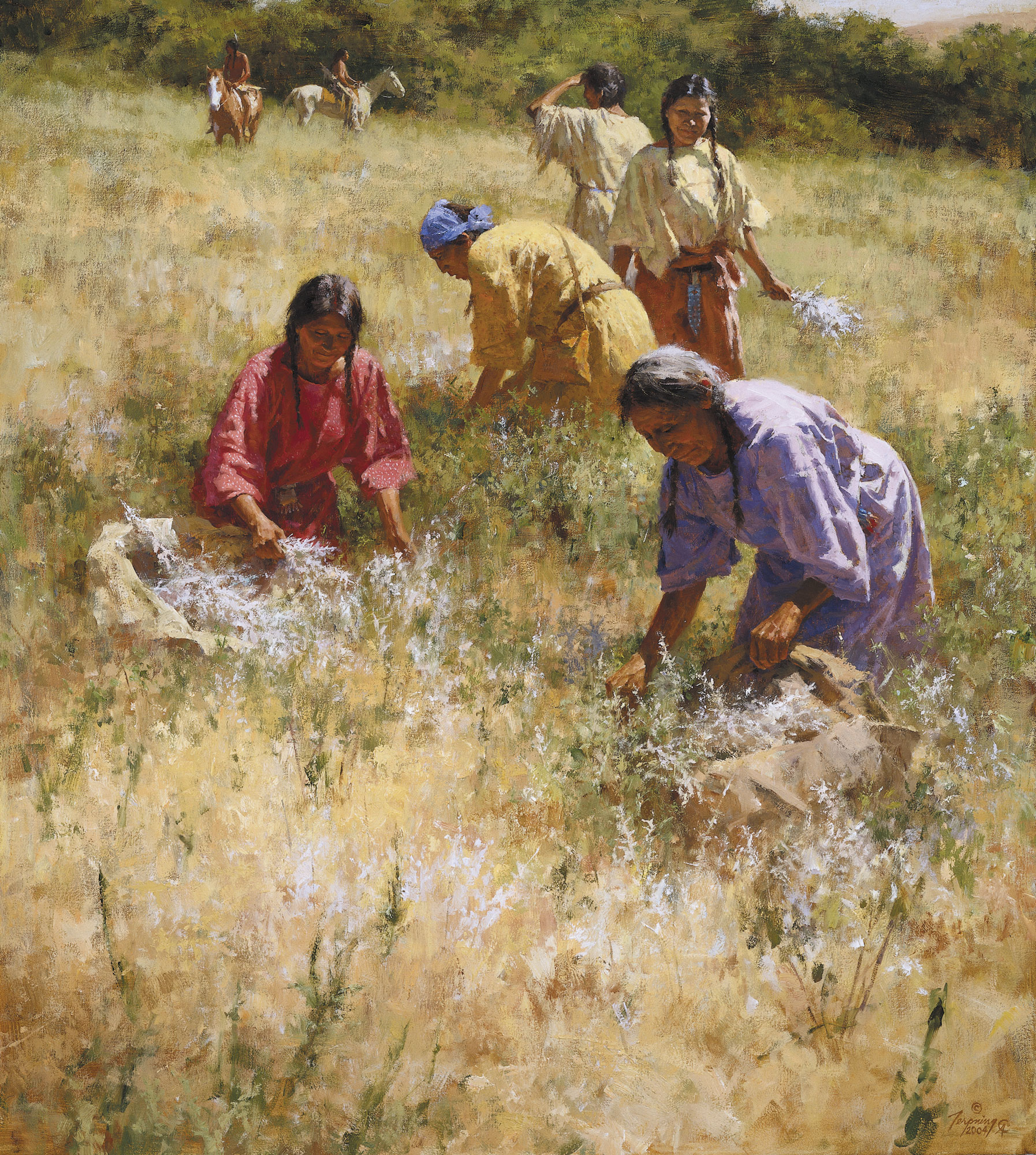
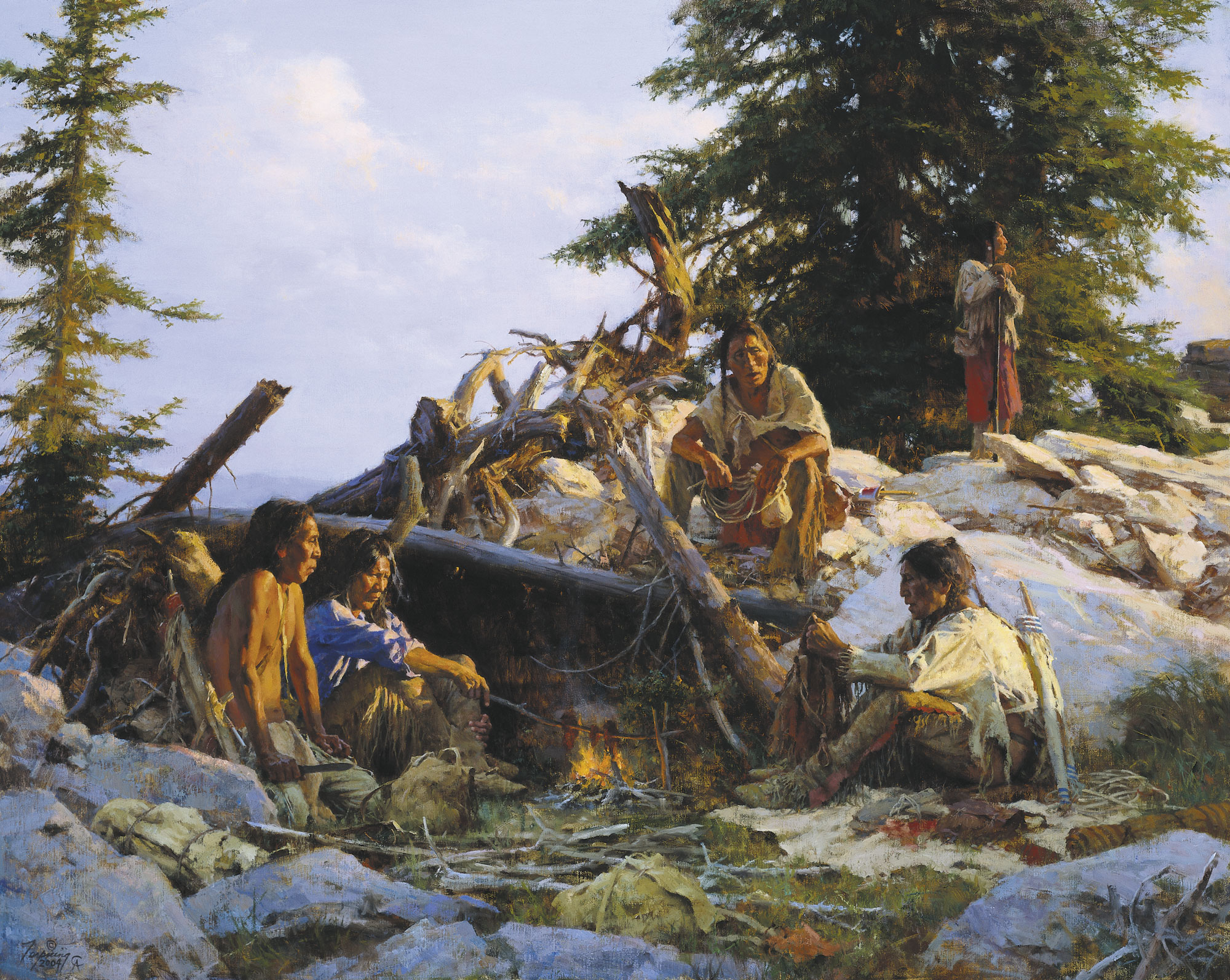
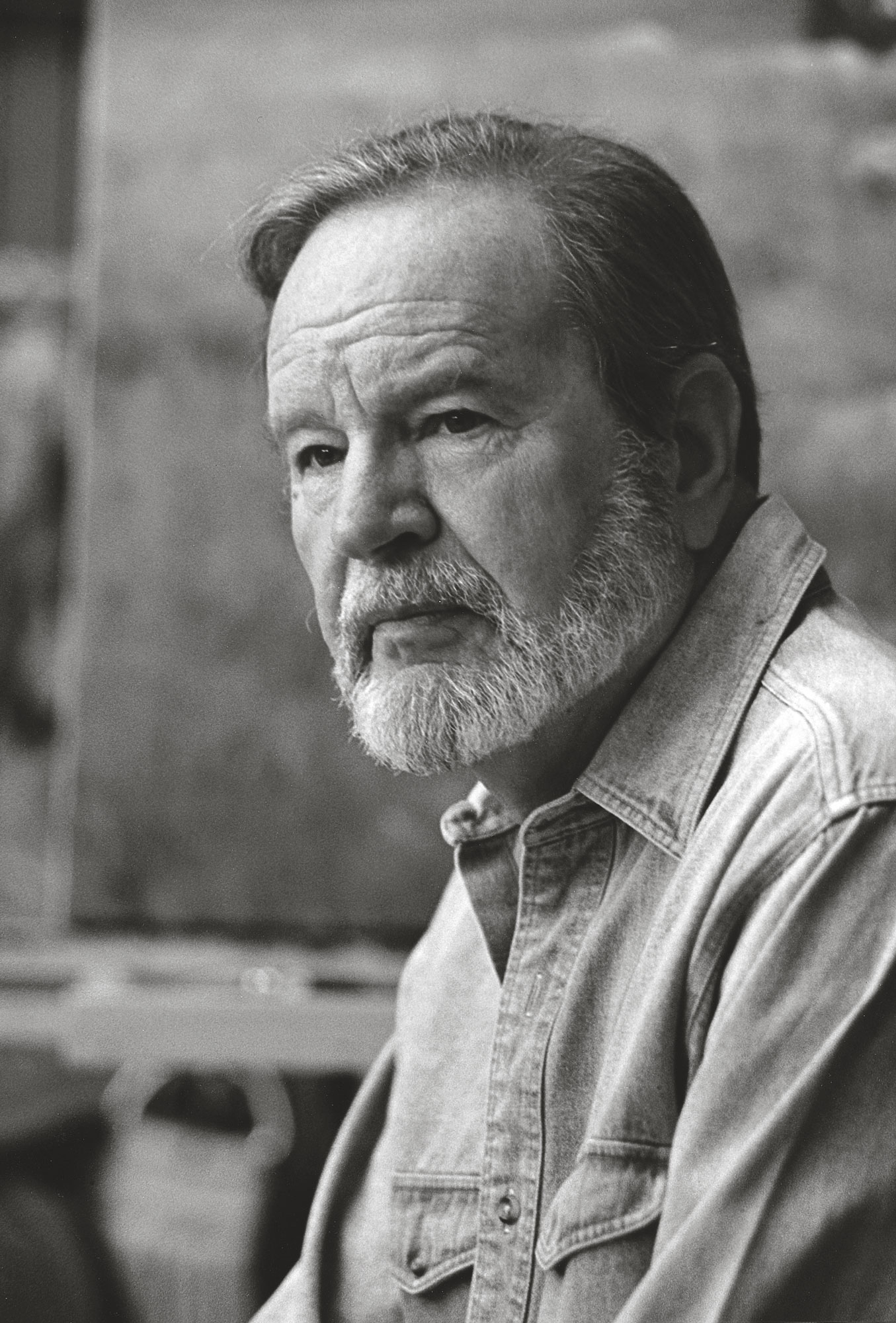
No Comments